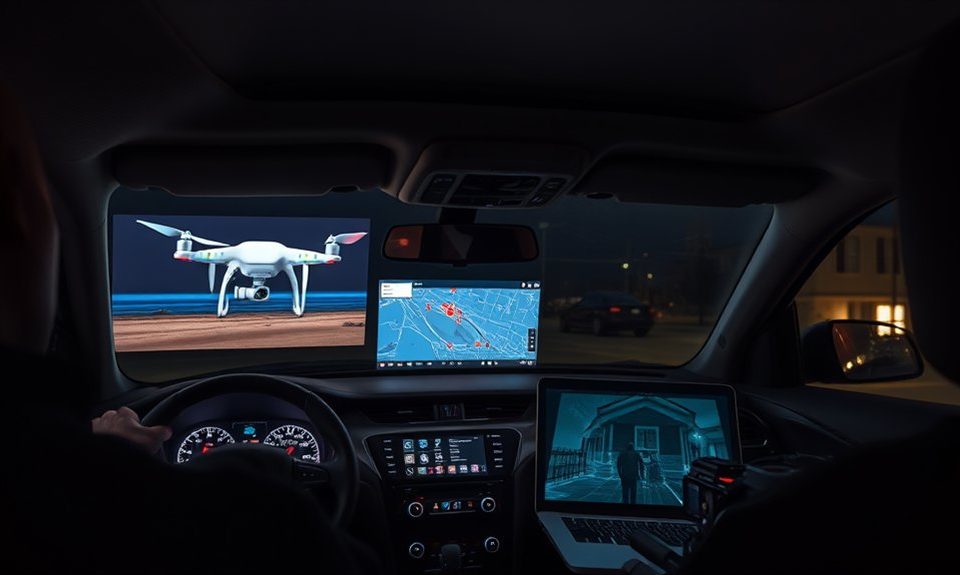Counter surveillance encompasses both physical observation and electronic detection methods to identify unauthorized monitoring. Professionals employ specialized equipment like RF detectors, thermal cameras, and signal analyzers to locate hidden devices and track potential surveillance. Strategic techniques include establishing detection routes, conducting security assessments, and implementing technical countermeasures. Understanding these fundamental practices reveals only the surface of this complex security discipline.
Understanding the Signs of Physical Surveillance
How can someone tell if they’re being watched? The signs of physical surveillance often reveal themselves through subtle patterns and recurring anomalies in daily life. Professional investigators identify these indicators through careful observation of surroundings and behavioral analysis.
Key signs include vehicles that repeatedly appear in different locations, individuals who maintain visual contact while pretending to be occupied, or people who mirror walking patterns and movements.
Other indicators may involve discovering surveillance equipment, noticing disturbed areas around property perimeters, or experiencing unusual technical difficulties with electronic devices. Additionally, advanced detection methods, such as Technical Surveillance Countermeasures (TSCM), can be employed to uncover suspicious activities and ensure a secure environment.
Modern Electronic Surveillance Detection Methods
Beyond physical surveillance, modern electronic monitoring poses an increasingly sophisticated threat to privacy and security.
Professional investigators employ advanced detection equipment to identify potential surveillance devices, including radio frequency analyzers, thermal imaging cameras, and non-linear junction detectors. These tools can locate hidden cameras, microphones, GPS trackers, and other covert monitoring equipment.
Skilled investigators methodically sweep premises for electronic signatures, wireless transmissions, and unexplained electromagnetic emissions. They also assess Wi-Fi networks, cellular signals, and Bluetooth connections for potential security breaches. In this context, employing advanced Technical Surveillance Counter-Measures is crucial for effectively securing environments against sophisticated monitoring technologies.
This comprehensive electronic counter-surveillance approach helps ensure clients maintain their privacy in an increasingly connected world.
Essential Counter Surveillance Equipment and Tools
Professional counter surveillance operations require specialized equipment to detect and prevent unwanted monitoring. Essential tools include radio frequency detectors for identifying hidden transmitters, thermal imaging cameras to spot concealed observers, and specialized software for detecting digital surveillance.
Private investigators employ GPS tracking detection devices, bug sweepers for locating listening devices, and advanced camera systems for documenting surveillance activities. Regular bug sweeps help ensure comprehensive protection against potential threats while mobile signal jammers provide additional protection against electronic tracking.
These tools, combined with proper training, enable investigators to conduct thorough counter surveillance operations.
Professional Counter Surveillance Strategies
Successful counter surveillance requires implementing proven strategies that private investigators have refined through years of field experience.
Professional investigators employ systematic approaches, including establishing surveillance detection routes, identifying choke points, and conducting thorough security assessments of vulnerable locations.
Key strategies involve pattern analysis of potential surveillants, deployment of technical countermeasures, and careful documentation of suspicious activities. Regular checks for listening devices are essential to enhancing these counter surveillance efforts.
Investigators often utilize multiple team members positioned at strategic locations to identify followers and verify threats. These methodical approaches, combined with experience-based instincts, allow professionals to effectively detect and counter unwanted surveillance activities.
Selecting a Qualified Counter Surveillance Expert
While implementing counter surveillance strategies is complex, choosing the right expert to execute them demands careful consideration. A qualified professional should possess extensive experience in detecting and countering both physical and electronic surveillance methods.
When selecting a counter surveillance specialist, verify their licensing, insurance, and track record of successful cases. Additionally, understanding state laws regarding surveillance can be pivotal in ensuring your approach is both effective and legal.
Stillinger Investigations, with offices across South Carolina, demonstrates the caliber of expertise needed, combining technical knowledge with practical field experience.
Their proven history in identifying surveillance threats and implementing protective measures exemplifies the qualities essential in a counter surveillance expert.
Conclusion
Counter surveillance expertise has become essential in today’s hyper-monitored environment. Understanding surveillance indicators, mastering detection methods, and utilizing appropriate tools enables individuals and organizations to protect their privacy effectively. As surveillance threats continue to evolve, professional counter surveillance services remain crucial for maintaining security. Selecting qualified experts and implementing comprehensive strategies helps ensure protection against both physical and electronic monitoring attempts.






